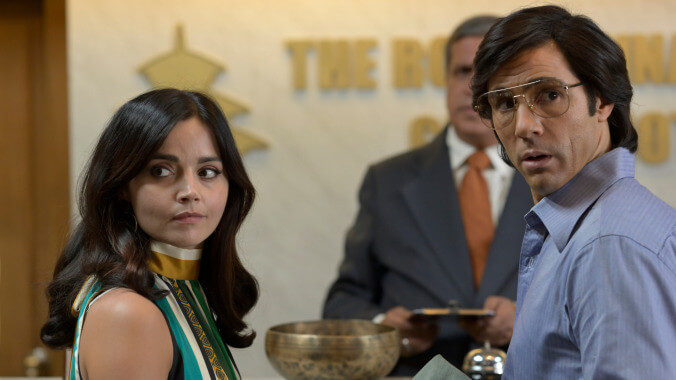Jenna Coleman and Tahar Rahim in The Serpent Photo: Netflix
The Serpent opens with a 1997 interview of French conman Charles Sobhraj, who skillfully sidesteps questions about whether or not he really is a murderer. It immediately paints a picture of him as an impassive, patronizing man. Sobhraj, a notorious serial killer during the late ’70s in Asia with at least 12 known victims, specifically targeted Westerners who traveled to the Hippie Trail in countries like Thailand, India, and Nepal. He was given the moniker of The Serpent because of how he dodged the law, evading capture on several occasions until his arrogance caught up with him. He is currently in a Nepali prison facing a life sentence. This entire saga is documented in this eight-part crime drama, a co-production between BBC One and Netflix that premiered in the U.K. in January and now arrives in the U.S.. While it retells the story of Sobhraj’s crimes, his victims, and the resulting investigations, the drama is devoid of any intensity and insights.
The eight-episode series stars The Mauritanian’s Tahar Rahim as Sobhraj and Doctor Who’s Jenna Coleman as his lover and accomplice, Marie Andrée-Leclerc. But when the series begins in November 1975, their alter egos in Bangkok are Alain Gautier and Monique, gem dealers quick to deceive young backpackers with the help of Sobhraj’s old friend and lapdog Ajay Chowdhury (Amesh Edireweera). They promise nomadic travelers fun times via lodging, drugs, and alcohol. Their home in the city, an apartment building called Kanit House, becomes a hotspot for them to poison their victims in order to steal their money, belongings, and passports. The Serpent establishes the devious trio’s modus operandi using real-life facts, which are further embellished by the cast’s performances and mannerisms: Rahim’s tight-lipped, know-it-all demeanor, Coleman’s side-eyeing smirk, and Edireweera’s emphatic and rowdy attitude.
The Serpent is essentially a dramatic reenactment of how the trio carried on their transgressions for several months in different cities without getting caught. The trouble in adapting a high-profile tale like this one is finding a way to introduce new information or explore relatively unknown aspects of the central figures. The Serpent captures the glitzy fashion of the era as well as its smoke-riddled and carefree atmosphere. But the series is ultimately neither introspective nor does it offer anything especially new besides, “Look, here’s nefarious people doing expectedly sinister things.” The slow-burn method turns watching the series into a chore, as viewers are bound to search the internet for information as opposed to waiting for answers ’til the last moment. Coleman gets to render a more emotive performance at times as Monique begins to question her place in this little team and in the world, but that arc doesn’t really go anywhere—not until the end.
The show finds an emotional footing in other characters like Herman (Billy Howle) and Angela Knippenberg (Ellie Bamber). Herman, a Dutch diplomat who was stationed in Bangkok at the time, makes it his mission to track down Sobhraj when he learns about him while investigating a missing Dutch couple who were The Serpent’s unfortunate victims. He gets help from his wife Angela, as well as Sobhraj’s neighbors Nadine Gires (Mathilde Warnier) and her then-husband Remi (Grégoire Isvarine). Nadine becomes an undercover operative of sorts for Herman, helping him mount evidence against the people she befriended and knew as Alain and Monique. The arduous journey undertaken by this ragtag team, with some help from other agents like Paul Siemons (Tim McInnerny) of the Belgian Foreign Service, does far more to anchor The Serpent than its titular figure. Warnier, in particular, is a revelation as Nadine.
Despite strong performances, though, the series takes an important story and loses it in unnecessarily complex time-jumping storytelling. It’s easy to lose track of all the title cards that flash with “2 months later” or “4 months earlier” or “10 months later” and on and on. In one episode, the story flashes back just a few minutes. As a way to make a straightforward story more exciting and anticipatory, The Serpent overuses this technique for it to make much of an impact. It would have been much more effective to provide deeper understanding of Leclerc’s motivations to stick around, Chowdhury’s reasons to follow Sobhraj blindly, or even an inkling as to what made Sobhraj who he is (like his neglected upbringing in France as a part-Vietnamese, part-Indian kid). The show is set in Asian cities like Bangkok, Hong Kong, Kathmandu, Mumbai, and Varanasi, and while The Serpent shows off their aesthetics and scenic beauty, it doesn’t do much to exhibit them as anything more than locales for the conman to commit his misdeeds.
The show hints at some potentially interesting tangents, like how Sobhraj’s charm helped him out while dealing with police (“Your vanity is powerful enough to defeat anything,” Monique exclaims at one point), and how hardly anyone, including those in various embassies and police stations, paid heed to missing travelers because they were branded as “ poor hippies.” It also occasionally focuses on the backstories of a few of the victims, making their fate more of a gut punch. It’s these narratives, as well as a couple of overdue high-octane cat-and-mouse chases in later episodes with Nadine at the center, that render meaning to a crime drama show like The Serpent, which otherwise plays out as more wooden than it should be, considering the true-life story it’s based on.









































